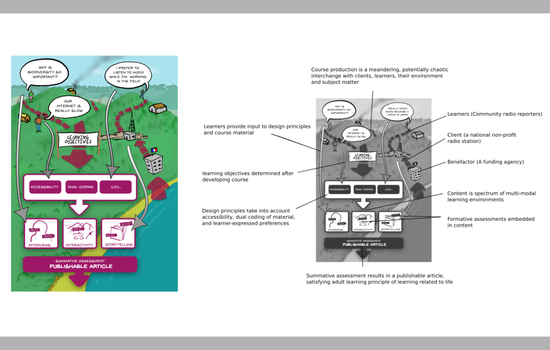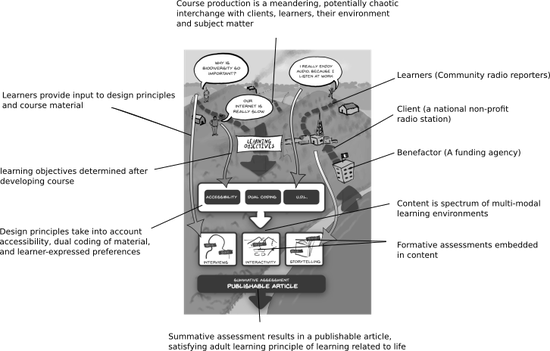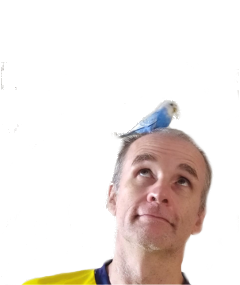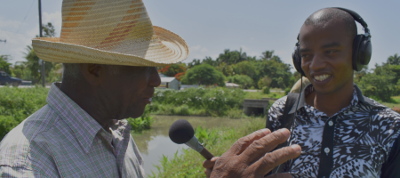
Participatory planning at a distance
Introduction
My project is a short, self-guided online course in environmental reporting for community radio reporters in Honduras. The course will adhere to constructivist principles as far as possible, including designer empathy and understanding of learners' context, participatory planning with learners and clients, and a focus on contextual knowledge and practice rather than universal technical knowledge. The end product of the course will be a publishable article which will embed learning within the learners' everyday lived experience.
Benefactors
The benefactors of the course are an international development funding agency and a national non-profit radio station in Honduras. These do not necessarily have the same interests and may not expect the same outcomes from the course. The funding agency is principally concerned with environmental regulation in the Caribbean, and sees the course as a means to the end of disseminating information through the media about endangered species in the region. The radio station is keen to improve the journalism skills of their contributing reporters, although not limited to environmental reporting. Both of these needs must be met -- and be seen to be met -- and negotiated by the course designer. As the course is developed, both will be kept up to date on progress with design documents and sample content, and they will be viewed by the designers as a resource for content ideas and material. The funder, for example, will have connections to environmental experts and access to policy documents. The radio station has an archive of radio stories that can used as models. Because our design approach is constructivist, and not prescriptive, course outcomes will developed through informal conversations with both, often in the context of requests for content ideas.
Learner Analysis
The learners are a group of community reporters employed on an occasional basis by the radio station. They live in rural regions, some quite remote, and will have day jobs unrelated to reporting. Many will be active in local associations of various kinds -- grass roots political, environmental, economic development etc. -- and will view their reporting as an extension of their activism. Most will be of the campesino class, or close to it through family, friends and work. Most will not have university education, but through their work and their association with the radio station they will be used to discussing abstract subjects. They may not have a computer, nor extensive technical skills, but all will have a cell phone and be familiar with navigating web sites. They are roughly evenly divided between men and women and between young and old. I don't believe they view this course, or journalism, as a career stepping stone, but I believe they will see it as an opportunity to enrich their work with the station and an opportunity to let other people know about problems they face in their communities.
Accessibility
In 2023, modern, standards-compliant HTML is already accessible by design (Mozilla, n.d.). The platform we have created for this course adheres to these standards: this includes the use of standard built-in forms for input, a high contrast interface, alt text for images, captioning on videos, transcripts for audio, and semantic html to aid screen readers with parsing. We will survey the relatively small group of learners for any accessibility problems we have not anticipated. Most content will presented in several forms, as text, for example, and an expert interview as part of our Dual Coding strategy of reinforcing learning through "verbal and visual pathways." (Cuevas & Dawson, 2018). This variety of media also complies with Universal Design for Learning principles of "providing multiple means of representation."(UDL Guidelines).


Summary
My diagram tries to capture the process of following a constructivist learning model as described by Willis (2009), Cennano (2009), Swan (2005) and Wagner (2021). The design process rejects a "rational-technical" approach (Willis, 2009) in which the designer knows everything, or at least knows what needs to be known. Instead, design is a creative process, that depends on a designer's instinct and familiarity with the learners' context, combined with deep engagement and "empathy" with the learners (Wagner, 2021). The path can't be planned, and may even be "chaotic" (Willis, 2009). We don't go as far as Cennamo (2009) to claim that "it is inappropriate to set learning objectives for the students" but we do believe that, because every learner interprets the material in their own way, we cannot set objectives until we have developed the course alongside them.
In my design, feedback will be sought and context appraised through close consultation with the client, a radio station, and the learners, community radio reporters. This process is represented as a meandering route through the countryside. Feedback will determine several major design principles. For example, there may be types of accessibility we have not considered, such as native language of the learners and availability of internet. We will implement a dual-coding strategy for content (Cuevas & Dawson, 2018), and decisions about which media and modes to use will be informed by learner-expressed preferences of learning styles. This mixed mode content also complies with Universal Design Principles, which aid accessibility (UDL Guidelines, n.d.) Learners and client will also contribute to the design of the content, for example, by proposing questions for the expert interviews and model news reports provided by the radio stations. This satisfies one of Knowles' adult learning principles, that adult learners "must have a hand in the design and development of their learning experience."(Pappas, 2014)
The content and student activities will be learning "environments" in the constructivist sense (Swan). These include rich interactivities such as explorable maps, but also more conventional material like text and interviews. While these latter are often seen as objectivist, rather than constructivist, I believe that lectures and text which are storylike are also "environments", with the interactivity located in the head of the learner as they follow the narrative.
Formative assessements are embedded directly in the content because "[c]onstructivism suggests that self-assessment is integral to learning" (Swan, 2005). The final summative assessment is the production of a publishable article. Feedback will be provided by the facilitator but no mark given. The true evaluation will come from seeing the article published and feedback from readers, thus linking the learning directly to the learner's everyday life.
References
Cennamo, K. (2009). Design as Knowledge Construction: Constructing Knowledge as Design. In J.W. Willis (Ed.) Constructivist Instructional Design (C-ID) (pp. 357-278). IAP-Information Age Publishing.
Cuevas, J., & Dawson, B. L. (2018). A test of two alternative cognitive processing models: Learning styles and dual coding. Theory and Research in Education, 16(1), 40–64. https://doi.org/10.1177/1477878517731450
Pappas, C. (2014) 9 Tips to Apply Adult Learning Principles to eLeanring. eLearning Industry https://elearningindustry.com/9-tips-apply-adult-learning-theory-to-elearning
Swan, K. (2005). A constructivist model for thinking about learning online. In J. Bourne & J. C. Moore (Eds), Elements of Quality Online Education: Engaging Communities. Needham, MA: Sloan-C.
UDL Guidelines (n.d.) The UDL Guidelines Retrieved on May 31, 2023 from https://udlguidelines.cast.org/
Wagner, E.D. (2021). Becoming a Learning Design. In J.K. McDonald & R.E. West. (Eds.), Design for Learning: Principles, Processes and Praxis. also for subtitle (pp. 1-20). EdTechBooks.com. https://doi.org/10.59668/id
Willis, J.W. (2009). Basic Principles of a Recursive, Reflective Instructional Design Model. In J.W. Willis (Ed.) Constructivist Instructional Design (C-ID) (pp. 283-312). IAP-Information Age Publishing.
Mozilla (n.d.) HTML: A good basis for accessibility. Retrieved May 31, 2023. https://via.hypothes.is/https://developer.mozilla.org/en-US/docs/Learn/Accessibility/HTML



